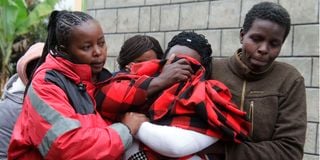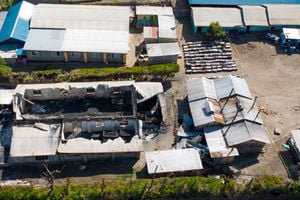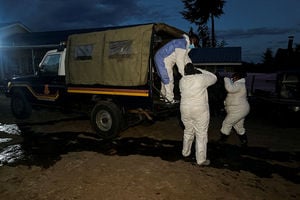
Parents grieve after visiting the scene where children died in a fire at Hillside Endarasha Academy in Nyeri County on September 6, 2024.
Laudably, the African Union (AU) declared 2024 the “Year of Education” to gift the continent with resilient and inclusive education systems offering lifelong, quality, and relevant education.
But the year has also seen a meteoric rise in violent incidents which make Africa’s education institutions unsafe spaces. Violent incidents in African schools rose dramatically by 20 per cent from 341 in 2022 to 411 in 2023, according to a recent report by the Save the Children, a humanitarian organization for children, released during the African Union (AU) Summit in February 2024. Creating safe schools is “in the best interest of the child”, a major norm in international human rights law.
Kenya’s schools are becoming dangerous places, as the country slowly joins the league of African countries with the highest death toll in schools worldwide, including Algeria and Nigeria. Over the past two decades, more than 1,000 Kenyan children have died in fire tragedies in schools.
This, by all means, is not a mere statistic. My own grandson, Earnest Ngaruiya Mwangi, was one of the 21 pupils who died in the horrific fire tragedy in a dormitory at Hillside Endarasha Academy in Nyeri County. He is the newest addition to a growing list of Kenyan children who continue to perish in fire-related incidents in schools — that the Government could have prevented.
Cast on a wider canvass, Earnest was one of over 14.9 million students in more than 43,000 private and public educational institutions in Kenya as of 2024, who are now sitting ducks for arsonists, terrorists and other criminals.
These include 10.4 million children enrolled in Kenya’s 32,469 primary schools, 3.9 million children in 10,502 secondary schools and over 563,000 studying in 69 Kenyan universities in 2022/2023, according to the 2023 Economic Survey by the Kenya National Bureau of Statistics and other Sources.
As the flickering embers of Endarasha die down, the fierce urgency now requires the Kenyan leaders to walk the talk and make schools safe for our children.
The Endarasha fire tragedy exposes the Kenyan school is a death-trap, with the eerie echoes of Africa’s deadly war zones. The Government official storyline on the Endarasha inferno is clear, and in the public space.
The school, now a crime scene, had a total of 823 pupils between the age of nine and 12 years enrolled, 330 of them boarders and 493 as day scholars. During the fateful night, 164 boys and 166 girls were in two dormitories.
The fire only affected 164 boys who were sleeping that fateful night in the dorm that went up in flames, leaving 21 pupils dead; 143 boys survived the inferno, with three injured and hospitalised, and 140 survivors fled home to their parents.
Endarasha is not an isolated case but the latest scene of a continuing national story of Kenyan children victims of terrorist attacks, arsonist fires abductions, bullying and other genres of crimes. September 11, 2024 must enter the annals of history as “Black Wednesday” when at least 10 school fire incidents were reported across the country, raising concern over the safety of the boarding school system.
Between May and September 2023, seven deaths from four deadly incidents in schools hit the headlines.
Kenya’s schools, colleges and universities are soft targets for arsonists and their ilk. Although education institutions are relatively vulnerable targets with a huge potential for mass casualties, they remain less security than other targets of such as military institutions, key government buildings, hotels and embassies, which are comparatively well-guarded.
With the rise of private schools, colleges and universities, rivals could turn to arson in an increasingly competitive business environment. Arsonists have often targeted school dormitories to cause maximum harm and struck at night when they can cover their tracks.
An easy explanation of causes of fires is accidents, often linked to faulty electrical appliances such as electric cookers and flammable substances. This is why Kenya Power came out to refute claims that the Endarasha tragedy was a result of an electrical fault.
In Endarasha, as in many other incidents, the government seems to be dithering as Rome burns, promising to ‘leave no stone unturned’ but the culprits going scot-free as tragic incidents erode the safety of learners. In Endarasha, authorities have neither confirmed nor ruled out arson.
The government has said it has “deployed relevant agencies” to probe the cause of the fire, assuring parents and the country that the probe would be conclusive.
So far, the police are mute on how many people have recorded statements in connection to the tragedy and offered no concrete information on on-going investigations.
This gap in the flow of information has fueled social speculations in media regarding the tragedy and even sparked protests from a group of activists, dubbed “Occupy Endarasha.”
It is Saint Augustine once quipped: “Charity is no substitute for justice withheld.”
Authorities should not give a pride of place to charity over justice. In the case of the Kyanguli Secondary School Machakos County, the highest death toll of any school fire in Kenya where 67 boys died and nine injured, the Kenyan government awarded parents of the affected children a total of 54 million Kenyan shillings ($419,384).
But this charitable support for the families did not bring closure to the tragic incident and the continued need for justice. In the case of the Endarasha Academy tragedy, the government has promised to foot all medical bills and burial expenses.
While this charity is salutary, we should never forget the ringing words of Dr. Martin Luther King Jr. who famously said: “The arc of the moral universe is long, but it bends towards justice.” The victims of Endarasha cry for Justice.
Facing the future, the government should revise and fully implement the Ministry of Education's Safety Standards Manual for Schools in all schools that establishes safety standards and guidelines to protect students in Kenyan schools.
Kenya should become a champion of the Safe Schools Declaration, an inter-governmental political commitment that provides countries the opportunity to express support the protection of students, teachers, schools, and universities from attacks.
It is high time the government walked the talk to make the school a safe place for our children to learn and grow.
Professor Peter Kagwanja is former Government Adviser, the Chief Executive at of the Africa Institute (API) and Adjunct Scholar at the University of Nairobi and the National Defence University (NDU), Kenya.






